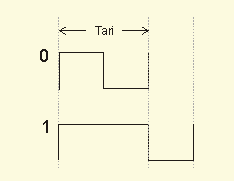About RFID Modulation Analysis
89601BHTC adds Radio Frequency Identification (RFID) modulation analysis capabilities to the 89600 VSA software. RFID is a technology that uses an active "interrogator" that can, using a modulated RFID signal, read a "tag." The tag is generally small and inexpensive and is powered by the interrogator's RF Radio Frequency: A generic term for radio-based technologies, operating between the Low Frequency range (30k Hz) and the Extra High Frequency range (300 GHz). signal. RFID tags can be attached to objects to provide product tracking, inventory control, or item authentication.
The RFID interrogator communicates with the tag by transmitting a modulated signal, followed by an unmodulated CW signal that provides power for the tag to respond.
The RFID tag generally responds to the interrogator by creating modulated backscatter in the reader's CW signal. This backscatter is read by the interrogator. The reader's signal powers the tag so it is useful to have the reader's signal be at its maximum value most of the time. This consideration means that RFID tag modulations differ from most radio communications protocols.
There are multiple incompatible RFID protocols. The RFID demodulator allows users to configure the VSA using preset values that select the desired RFID protocol and so configure the VSA settings.
Certain terms used in RFID are similar to those used in other radio-frequency technologies, but have specialized meanings in RFID. The following terms, which are described below, are used in describing RFID signals in the 89600 VSA software documentation.

This refers to a contiguous set of ASK (or FSK Frequency Shift Keying: A form of modulation using multiple carrier frequencies to carry the digital information. The most common is the two frequency FSK system using the two frequencies to carry the binary ones and zeros.) symbols from a single transmitter. It does not refer to the entire CW signal.
This is the entire signal from where the Interrogator power turns on until it turns off. In other circumstances this would be referred to as a “pulse” or a “burst”, but for RFID “pulse” and “burst” are otherwise defined.
The transmission from Interrogator to Tag.
This always refers to a single pair of ASK symbols, where the RF envelope goes low > high > low or high > low > high. The term pulse is never used to refer to the entire CW signal.
The transmission from the Tag to the Interrogator.
This is the length of a binary '0' in the interrogator's line coding. A binary '0' is a short high level pulse followed by low pulse of equal length; a binary '1' is a longer high pulse followed by the same low pulse width. This symbol set provides a high average RF power delivered to the tag. The length of a binary '0' is defined as and is used as a reference for several other times in the standard.

For more information, see the "Keysight 89600 VSA Software RFID Modulation Analysis" Technical Overview and Demonstration Guide in the Product Literature section of the 89600 VSA online help.
See Also
Selecting the RFID Demodulator
